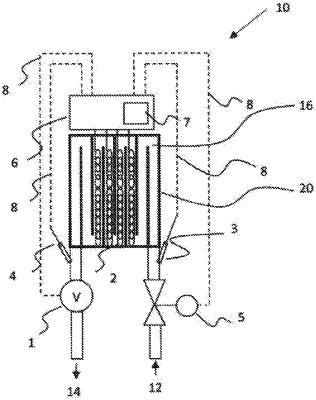| CPC F24H 1/101 (2013.01) [F24H 9/2028 (2013.01); G01F 1/05 (2013.01); G01K 13/02 (2013.01); H05B 3/82 (2013.01); F24D 2200/08 (2013.01); F24D 2220/0271 (2013.01); F24D 2220/042 (2013.01); F24D 2220/044 (2013.01); G01K 13/026 (2021.01)] | 11 Claims |

|
1. A tankless water heater comprising:
an inflow terminal for connecting the tankless water heater to a cold water supply;
an outflow terminal for connecting the tankless water heater to a tap;
a fluid channel providing a fluid connection from the inflow terminal to the outflow terminal;
an electric heating element arranged at or within at least a section of the fluid channel, the electric heating element being configured to heat fluid present within the fluid channel;
a flow sensor arranged at or within the fluid channel downstream of the heating element; and
an electronic controller configured to:
control a heating power provided to the electric heating element,
detect the presence of air bubbles within the fluid channel based on a change of a flow signal provided by the flow sensor,
in response to air bubbles being detected, adapt the heating power provided to the electric heating element, and
delay the onset of providing heating power to the electric heating element after the flow signal becomes indicative of a start of a tap event.
|
|
11. An electronic controlled point of use water heater comprising:
an inflow terminal for connecting to a cold water supply;
an outflow terminal for connecting to a tap;
a fluid channel providing a fluid connection from the inflow terminal to the outflow terminal;
an electric heating element arranged at or within at least a section of the fluid channel, the electric heating element being configured to heat fluid present within the fluid channel;
a flow sensor arranged at or within the fluid channel downstream the heating element; and
an electronic controller configured to:
control a heating power provided to the electric heating element,
detect the presence of air bubbles within the fluid channel based on a change of a flow signal provided by the flow sensor, and
in response to air bubbles being detected, adapt the heating power provided to the electric heating element such that the heating power is greater than zero.
|